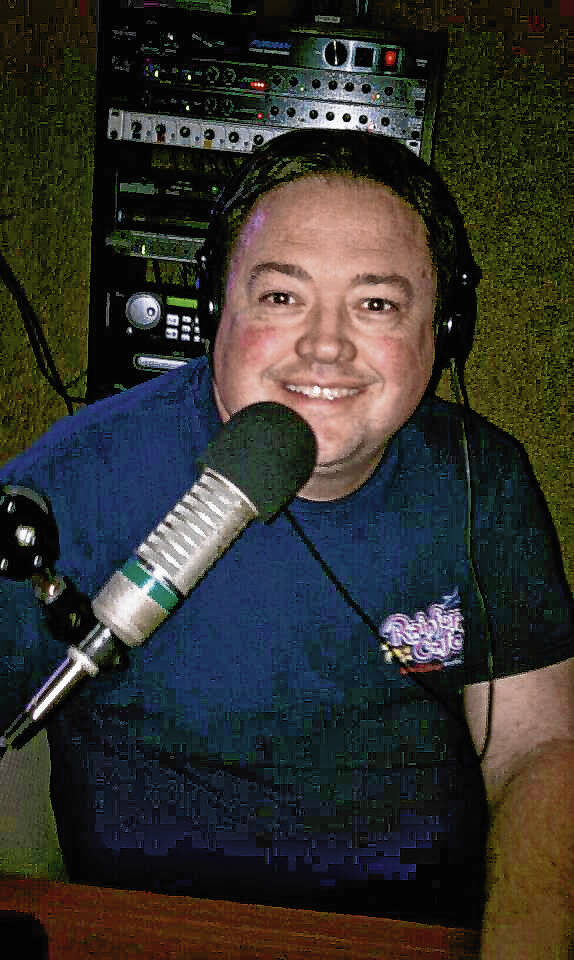
Marty Hensley, a longtime radio pro and a 1979 Columbus East High School graduate, is among those who’ve brought 1970s Indiana radio staple WNAP back to life.
If you were a baby boomer raised locally, you likely remember a popular Indianapolis-based rock radio station called WNAP in the late 1960s and 1970s.
Well, that same station — also known as the Buzzard — is back.
With studios in Muncie, WNAP (91.7 FM locally) is striving to bring back some of what made the original station popular: rock, oldies and personalities, a spokesman said.
The 6,300-watt radio station is licensed to Morristown, just north of the Bartholomew-Shelby County line. However, a broadcast translator station in Edinburgh boosts the signal, bringing it clearly into the Columbus area. The also station is available on the internet at Y365.com.
Long-time fans
While others were involved, the return of the Buzzard is largely the work of 1979 Columbus East High School graduate Marty Hensley, who now works with five radio stations with studios headquartered in Muncie.
Besides Hensley, another avid fan of the original WNAP is Columbus native Ron Gates, who retired in 2014 as a high-level executive from a company that owned or managed 53 radio stations. Gates, who returned to his hometown, also recalls that Hensley has maintained a strong enthusiasm for radio broadcasting for as long as he can remember.
“When Marty was a young kid, he wanted to get into radio so badly,” Gates said. “You have to respect somebody who has maintained their love of what they did as a young teenager.”
After starting his career with White River Broadcasting in Columbus, Hensley moved on to the Indianapolis market where he worked at stations that included The Buzzard. As for Gates, he appreciated the original WNAP format so much that he tried to replicate it at a Minnesota radio station that were among many he managed.
The “Naptown” era
For almost a decade, WNAP was so popular that truckers across the country referred to Indianapolis as “Naptown” while talking on their CB radios. “Nap” refers to the fourth syllable in Indianapolis, and the Buzzard signified a desire for WNAP to eat the competition in the ratings.
“WNAP was a phenomenal station in the early to mid ‘70s,” Gates said. “They had a group of announcers almost beyond compare like Buster Bodine and Adam Smasher. They were entertaining, hip and relevant.”
Renowned annual events included the WNAP Raft Races in July, which attracted tens of thousands of young people to see fearless (or intoxicated) young people navigate floatables of their own design down the White River. But most patrons recall the highlight was a huge party featuring a large outdoor rock show in Broad Ripple Park.
Many also thought WNAP was the ‘cool’ station because they worked with Sunshine Promotions to present concerts by chart-topping rock groups.
The fall
So when did the “Wrath of the Buzzard” start to fade away? Television documentaries and books have been developed about the so-called “Naptown Rock Radio Wars” that provide in-depth answers to that question.
But Gates recalls that when a programmer decided to add disco music on WNAP playlists, the move was detested by listeners and announcers alike. According to a music history website, rock purists considered disco overproduced, rhythm-heavy and trite. They also felt disco nightclubs promoted a lifestyle of hedonism, money and the emphasis of appearance over substance.
“They kind of gave the market over to Q95 (WFBQ 94.7 FM) without really realizing they were doing it,” Gates said.
When disco emerged on the Buzzard, WFBQ saw its chance. They responded by first eliminating automated programming and hiring high-quality announcers who provided an edge and attitude, Gates said. It was the 1983 arrival of morning show hosts Bob Kevoian and Tom Griswold that allowed Q95 to become the top classic rock station in Indianapolis.
“And they’ve remained pretty steady ever since,” Gates said.
“The Buzzard” faded off the radio in 1986. There was an effort in 1994 to revive the station at 91.7 FM with syndicated radio host Howard Stern, but Hensley said that incarnation was unsuccessful and went off the air in 2000. For a time, WNAP was a now-defunct radio station that used to serve Norristown, Pennsylvania (population 34,324). But eventually, Hensley was able to purchase the call letters and bring them back home to Indiana.
Delicate matters
Hensley should be commended for doing many things the right way in his efforts to gain a following, Gates said.
“But Marty has a remarkably hard challenge ahead of him with the restraints that he has,” he added.
Gates is largely referring to the fact that Hensley is also a Christian minister and the station is affiliated with his ministry, New Beginnings Movement, Inc.
“For a long time, we did gospel, but with K-Love (WKLU 101.9 FM) coming into the market to play Christian Contemporary music, they did an awful lot of things that we couldn’t do,’ Hensley said. “We also learned that only about 10% of people who go to a church listen to Christian radio”.
A church-affiliated classic rock and oldies station may sound like an odd combination. But despite what many think, there is surprisingly little obscenity in that type of format, Gates said. That’s largely because much of the music had radio-friendly versions when they came out, Gates said.
Hensley says he and others consider songs on a case-by-case basis. But the minister said he will not permit a song that takes the Lord’s name in vain. And it should go without saying that the Rolling Stones’ “Sympathy For The Devil’ will remain off the pastor’s playlists.
The other challenge is financial. Much like public radio, funding for WNAP relies on sponsorships and individual donations, rather than playing commercials. That means the station will face more financial restraints that conventional broadcasters. Hensley said he refuses to use his ministry to persuade companies to provide sponsorships.
Doing it right
What the new WNAP is doing right is recruiting announcers like Bob Hawkins and Rhonda Bennett who volunteer their DJ services out of a love of radio. To help promote the brand, each announcer has a radio name that includes “Buzzard” in it.
If you think the station is serving up heaping portions of nostalgia, Hensley probably wouldn’t argue with you.
“Mainly, what we try to do is use the music we play to try to bring back memories of when folks were kids,” Hensley said. “A lot of people say when they hear our station, it makes them think of what they were doing when the song came out. The nice thing is that there is no other station doing what we are doing.”
With a 5,000-song playlist, the new WNAP is also more likely than commercial stations to play a song you have not heard in several years. Many hired radio consultants recommend limiting playlists of commercial stations to perhaps 300 well-tested songs that show widespread appeal in listener surveys.
Well-tested songs usually exclude deep album cuts, but Hensley says the new WNAP gives a number of those songs airplay, as well as progressive rock and rhythm and blues.
Will live programs return?
Both Hensley and Gates say they believe the best way to attract new listeners is to recruit talented and entertaining announcers, rather than hire people who read information off cards.
Showcasing talent is more difficult these days with many stations using voice-tracking software, which requires a disc jockey to prerecord the parts when they speak on the radio, Gates said. Voice-tracking gives the listener the illusion of a person doing a live shift, but in reality, it allows a DJ to record a three-hour shift in less than a half-hour.
While Gates understands voice-tracking increases productivity, radio stations will eventually have to rely on entertaining announcers to lure listeners away from digital services such as Spotify or Youtube Music.
Although the new WNAP is gaining listeners, Gates says it’s important to remember the listeners are different.
“People change over time,” Gates said. “Now, instead of talking to a 17-year-old (with a rebellious attitude), WNAP is talking to a 50, 60 or 70-year-old who understands there can be positive things about life. You have to talk to them that way.”




